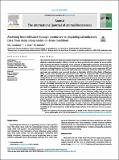Por favor, use este identificador para citar o enlazar a este item:
http://hdl.handle.net/10261/296470COMPARTIR / EXPORTAR:
 SHARE SHARE
 CORE
BASE CORE
BASE
|
|
| Visualizar otros formatos: MARC | Dublin Core | RDF | ORE | MODS | METS | DIDL | DATACITE | |

| Título: | Assessing heat tolerance through productive vs physiological indicators. Data from dairy sheep under on-farm conditions |
Autor: | Carabaño Luengo, María Jesús; Díaz, Clara; Ramón, Manuel CSIC ORCID | Palabras clave: | Body temperature Climate change Heat stress Milk production Respiratory rate |
Fecha de publicación: | 8-oct-2022 | Editor: | Elsevier BV | Citación: | Animal 16(11): e100662 (2022) | Resumen: | The search for criteria that allow the quantification of the level of thermotolerance of an animal is a major challenge in animal production. Different criteria have been proposed to date, mainly the use of routine milk recording and weather information or the collection of physiological measures related with heat stress. This study aimed at quantifying the association between indicators of heat tolerance derived from productive and physiological traits. For this purpose, two physiological traits, rectal temperature (RT) and respiratory rate (RR), and nine productive traits (milk yield, fat, protein and lactose yields and contents, casein and urea contents) were measured from June to September of 2018 in three flocks of Manchega sheep. A total of 462 lactating ewes participated in the study. Air temperature (Ta), relative humidity (RH) and associated temperature and humidity index (THI) were recorded inside the barn and also obtained from the closest weather station from the national meteorological network, and used to produce several measurements of heat load on animals. Based on the results of fits for quadratic and cubic regressions on the alternative heat load measures, the cubic regression on Ta and THI obtained inside the barn at time of recording yielded the best fit for physiological and productive parameters. The use of weather information taken from the official weather station closest to the farm also produced similar estimates and could be considered as a good alternative when on-farm meteorological data are not available. Two-trait random regression models that involved individual intercept and slope of response to heat load were used to obtain correlations between basal levels and heat tolerance within and across traits. Estimated correlations showed that animals with smaller vs larger basal levels of RT and RR tend to be more vs less heat tolerant (correlations up to 0.46) and that slopes of increase for RR and RT under heat stress were highly correlated (0.82). Estimated correlations between tolerance criteria from production vs physiology were up to -0.5 (between milk yield and RT), indicating that animals that show less increase in body temperature also tend to show a smaller decrease in production under heat stress. However, because of the non-unity correlation between the two types of indicators of heat tolerance, both sources of information, productive and physiological ought to be taken into account to ensure the long-term sustainability of selection programmes aiming at improving productive levels when heat stress is a concerning issue. | Descripción: | 11 Pág. Departamento de Mejora Genética Animal | Versión del editor: | https://doi.org/10.1016/j.animal.2022.100662 | URI: | http://hdl.handle.net/10261/296470 | DOI: | 10.1016/j.animal.2022.100662 | ISSN: | 1751-7311 |
| Aparece en las colecciones: | (INIA) Artículos |
Ficheros en este ítem:
| Fichero | Descripción | Tamaño | Formato | |
|---|---|---|---|---|
| Assessing-heat-tolerance-through-productive.pdf | artículo | 744,61 kB | Adobe PDF |  Visualizar/Abrir |
CORE Recommender
SCOPUSTM
Citations
2
checked on 18-may-2024
WEB OF SCIENCETM
Citations
1
checked on 25-feb-2024
Page view(s)
40
checked on 17-may-2024
Download(s)
33
checked on 17-may-2024
Google ScholarTM
Check
Altmetric
Altmetric
Este item está licenciado bajo una Licencia Creative Commons



